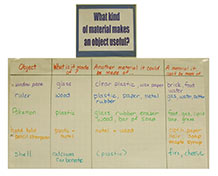What kind of material makes an object work well?
3. Make meaning
Review the class table in light of the investigation question:

This teacher has used different colored markers to clearly delineate the different rows of the table, giving a visual cue to understand the way the data is organized.
Purpose of the discussion
The purpose of the discussion is to heighten students’ awareness of relationships between a material, its properties, and an object’s function.
Engage students in the focus question
Based on the information in our class table, what kinds of materials make an object work well?
Use the data from class table.
Ask students to provide a rationale for their ideas.
- The material used in [object] is [what it is made of]. Does anyone else have an object that uses this material?
- Do you think that this [other object] could also be made of [the alternative material] Why do you think that?
- Do you agree your [other object] would not work well if it were made of [the inappropriate material] Why do you think that?
Have students defend their claims about alternative or inappropriate materials.
For example,
- “Yes, that material would also work in this object because it’s hard [or it’s strong, or it’s slippery].”
- “No, that material will not work in this object because it’s shiny [or it’s too heavy or it’s the wrong color].”
What would you say to a person who asks, “What kinds of materials make an object work well?”
Listen for responses that indicate students recognize that the choice of material will depend on the function of the object and the properties of the material.
Continue with this discussion, moving through the 5 objects students added to the classroom list. The purpose of this exercise is to heighten students’ awareness of relationships between a material, its properties, and an object’s function.



